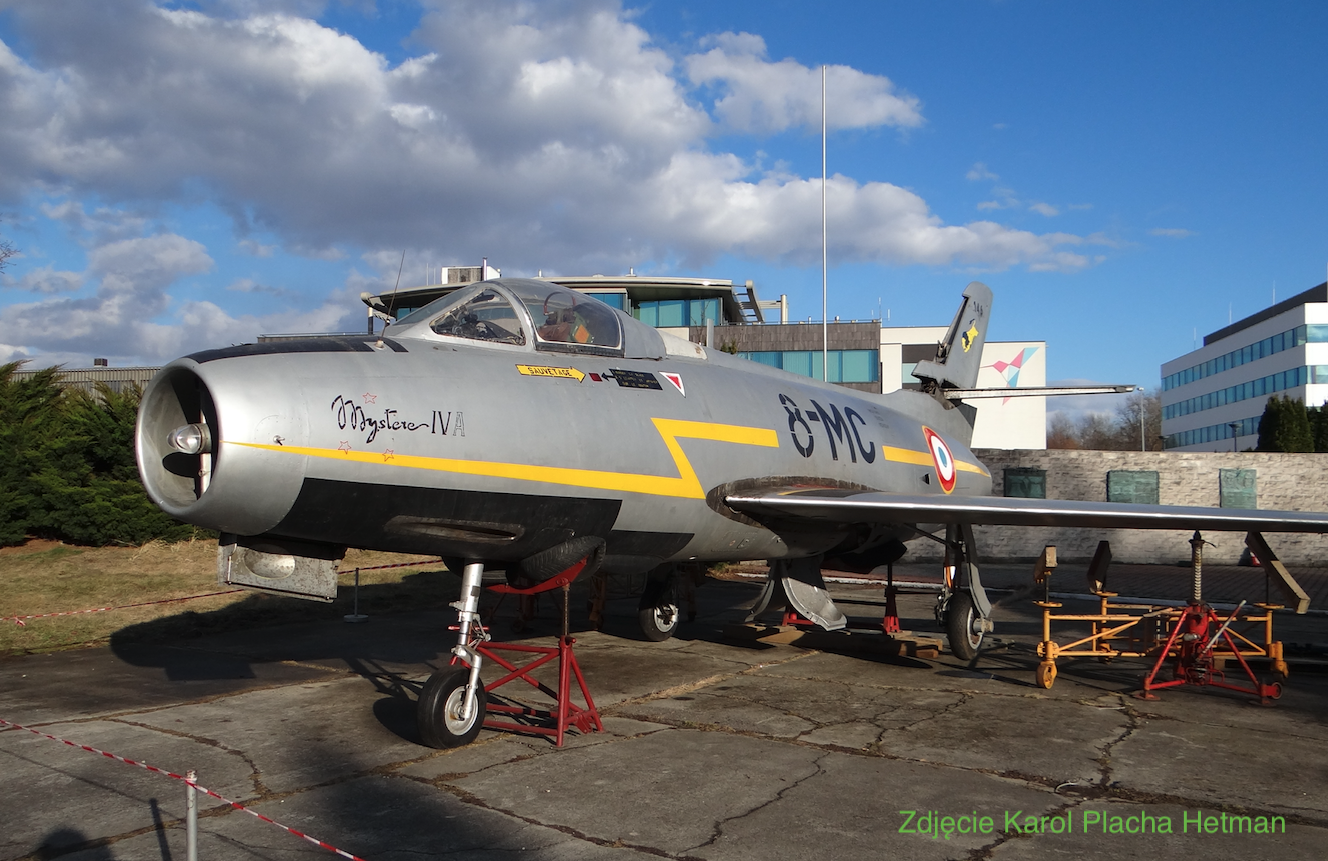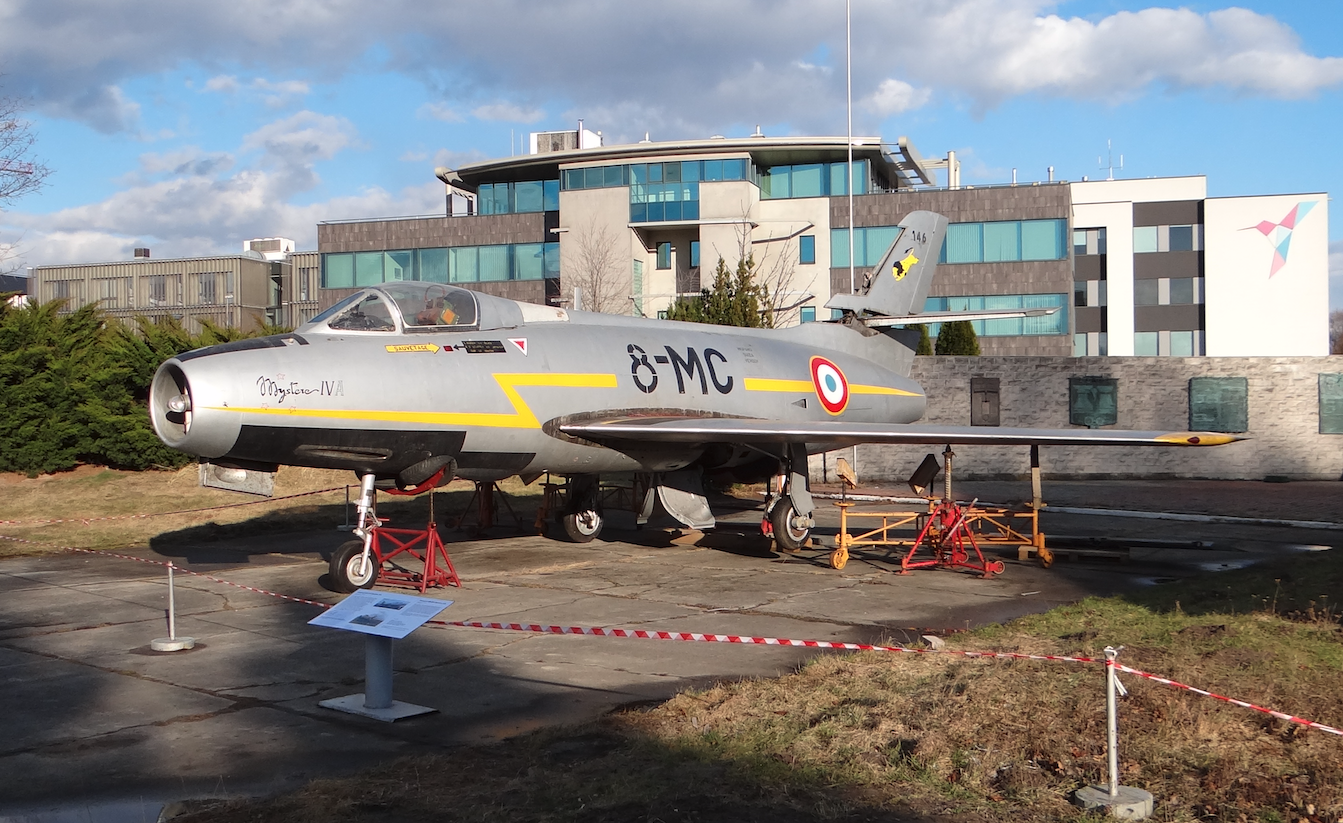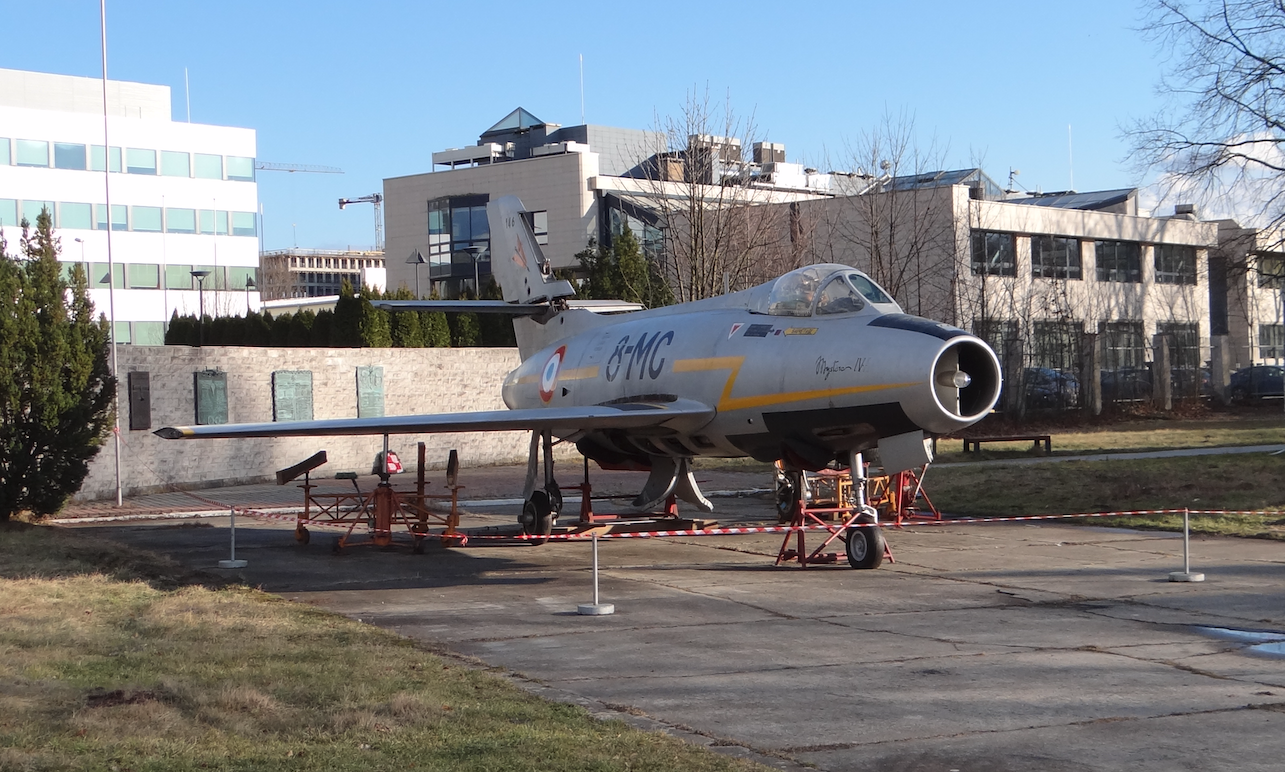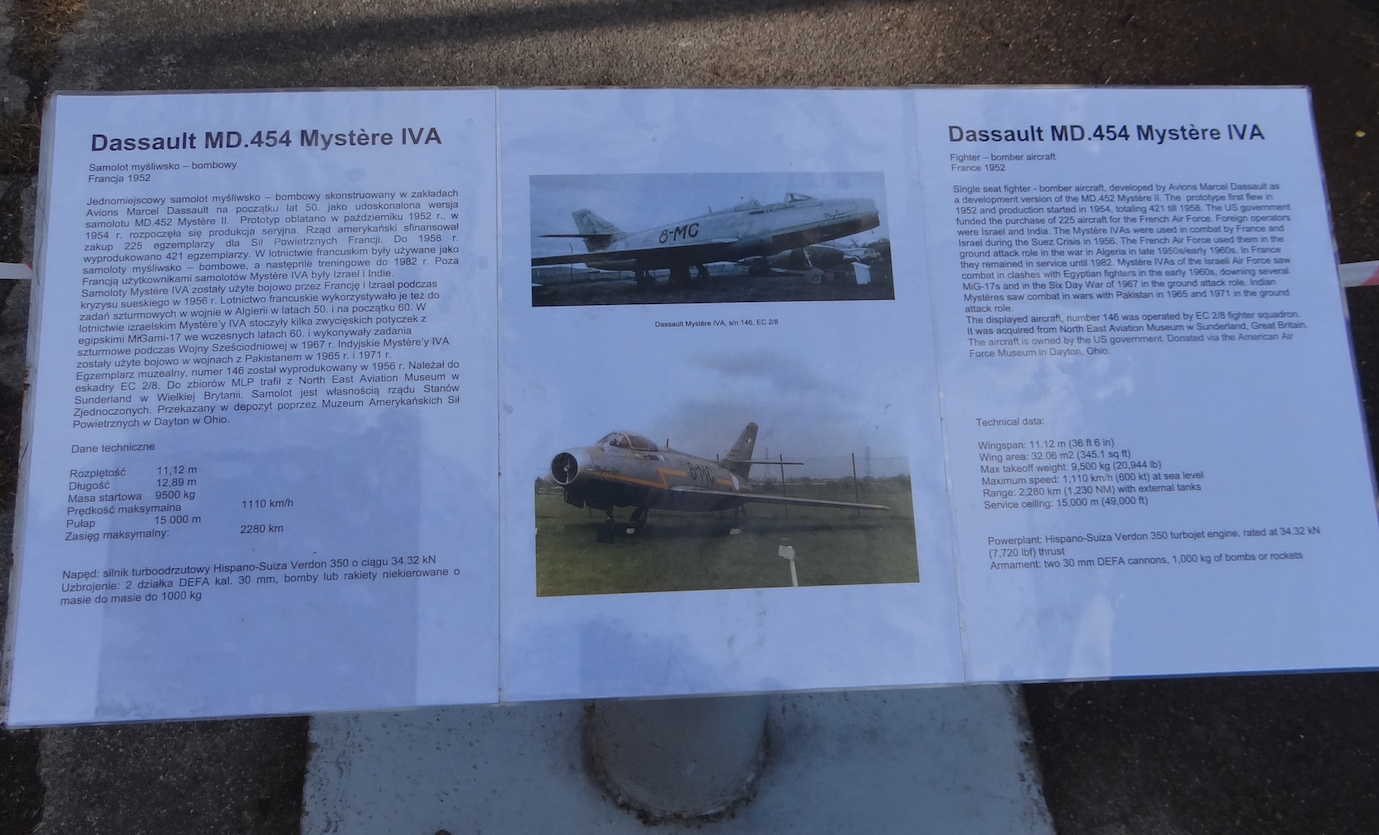Kraków 2020-02-18
New exhibit at the Polish Aviation Museum in Czyżyny.
Marcel Dassault M.D. 454 Mystere IV A.
Marcel Dassault Mystere IV A.
Dassault Mystere IV A is a French fighter-bomber aircraft built by Marcel Dassault. In January 2020, the plane went to Krakow on the basis of a deposit agreement with the American National Air Force Museum. Once assembled, the aircraft will be exhibited at the Museum in the 50/60 aviation area of the 20th century.
Dassault Mystere IV A aircraft No. 146, made its first flight on 1956-02-17. It was used in the Armee de l’Air (French Air Force). This copy is a so-called red plane, i.e. it participated in combat flights during the war in Algeria. In May 1978, after leaving the service, he was transferred to the RAF base in Sculthorpe, Great Britain. The aircraft received 4,255 hours of flight time. From May 1982 to January 2020, the aircraft was exhibited at the North East Land Sea and Air Museum, near Newcastle. The aircraft is owned by the National Museum of the USAF at Dayton Branch in Ohio.
History Dassault Mystere IV A.
The first successful French fighter aircraft was Marcel Dassault M.D. 450 Ouragan (Hurricane). The first flight took place on 1949-02-28. At that time, Marcel Dassault (before World War II Marcel Bloch), a constructor, engineer, head of the company and co-owner of the company, in one person decided to improve the plane. He had another argument in his hand – French politics. This policy opened his way to the markets of countries that were not associated with the US or CCCP.
The new aircraft was designated Dassault 452-01. The aircraft was equipped with the Nene – Hispano Suiza 104 B engine, with a draft of 22.6 kN. The wing was changed, which, according to foreign constructions, received a slant, worth 30 degrees. The Dassault 452-01 aircraft made its first flight on 1951-02-24. Then the plane was called Mystere, or Mystery.
Then the designers received a new Hispano Suiza Tay 250 engine, with a draft of 28.0 kN, also based on a British license. In this way, Mystere II A planes (armed with 4 20 mm cannons) and Mystere II B (armed with 2 30 mm cannons) were developed. The Mystere II aircraft was successful and practically only awaited the public order. But the technical progress was so fast that the engineers already had at their disposal the French SNECMA Atar 101 engine, with a draft of 29.4 kN, which already has an axial compressor. Mystere II C was built with this engine. Eleven prototype aircraft were built. During the tests, the Mystere II C aircraft exceeded the speed of sound during a dive flight.
At the same time, the Mystere III aircraft was developed. It was supposed to be a night fighter equipped with a radar sight. Initially, the AI Mk.17 or AN / APG-33 radar was proposed, which was placed in the nose of the aircraft. This forced the use of side air intakes. The eleventh prototype M.D. became the basis for building this aircraft. 450 Ouragan. The first flight was made on 1952-01-24, and the structure was marked MD 450-30-L. Work on the plane was discontinued because the Mystere II airframe was reached and radar was installed on it. The new aircraft was designated M.D. 453 Mystere III, often given with the index ‘N’ or the term ‘Denuit’. The aircraft had a Hispano-Suiza Tay 250 engine with 2,850 kG. Three prototypes were built, of which the first made the flight on 1952-07-18. Interestingly, none of the prototypes was mounted radar. The first prototype made 146 flights and the tests were completed in December 1953. The plane was rated as very poor and the radars were underdeveloped.
Work on modernizing the Mystere II aircraft was continued. On 1952-09-28 he made the first flight marked M.D. 454 Mystere IV A. A Hispano-Suiza Verdon 350 engine was installed, which was a variation of the Rolls-Royce Tay model. The engine thrust is 34.40 kN. The airframe received a longer hull. The slant of the lobe was brought to 38 degrees. Some literature gives a value of 41 degrees. A thinner profile was used, with a relative thickness of 7.5% instead of the previously used 9%. Thanks to these changes, the max speed and climb speed have improved. The plane reaches a Ma-1.2 speed in slight descent.
There could be only one decision by the French government. The M.D. aircraft was introduced into production. 454 Mystere IV A. A total of 450 copies were planned to be produced. Of this number, around 230 were to be armed with NATO countries in Europe. The demand for about 110 units was made by Indian aviation, and the remaining ones were intended for the aviation of Israel and of course France. The construction of 225 aircraft was financed by the American Administration for French aviation. A total of 421 Mystere IV A aircraft were produced.
The aircraft at the turn of the 1950s and 1960s was the best fighter aircraft in French aviation. The Mystere IV A aircraft served in French aviation for 30 years, until 1982. In India’s aviation, the Mystere IV A aircraft took part in the war with Pakistan, from 1971-11-21 to 1971-12-17.
Other aircraft prototypes Mystere IV.
Mystere IV B – development version of Mystere IV A, not mass produced. The construction of the only copy was completed in December 1953. The first flight was made on 1953-12-16. The drive is a British R-R Avon R.A.7R turbine, with 1 x 42.3 kN afterburning. (without afterburning 1 x 33.4 kN) Armament as in version A. In March 1954, the aircraft was presented to the French government. Pilot-flyer Rozanoff sat at the controls of the aircraft. The first Frenchman who exceeded the speed of sound during a dive flight. Unfortunately, during this presentation the pilot made a mistake and the plane crashed into the ground, burying the aviator.
Mystere IV N – a two-seater night fighter equipped with a radar with an antenna placed in the deflector above the air inlet. He made his first flight on 1954-07-19. The aircraft was not mass-produced. The drive is the R-R Avon R.A.7R engine.
On 1954-06-27, one of the most tragic disasters in the history of French military aviation occurred. On this day, air shows were held at Valenciennes-Denain Airport. Among other things, on the Mystere aircraft, pilot-flyer Andrew Tesson demonstrated crossing the sound barrier. Mainly it was about creating a sound thunder effect. To increase the attractiveness of the show, the pilot’s words spoken on the radio were heard by viewers, through numerous megaphones. During this flight, the fighter lost control while in dive. The pilot decided to catapult, but first he had to discard the cabin cover. However, the cover could not be opened. Time was running out and the earth was getting closer. The pilot decided to use the catapult without rejecting the fairing and at that moment he hit his head on the structure of the cabin glazing and was killed. The plane crashed into the ground. Thousands of people saw and heard the drama of the pilot.
Construction Mystere IV A.
Single-seat, single-engine fighter aircraft. Low wing.
Inclined wings of 38 degrees, with zero rise and zero wedge. The relative thickness of 7.5%. The wings are equipped with ailerons and crocodile flaps.
The fuselage is oval, technologically divided into two parts. The rear part is subtracted for access to the engine. Pressure cabin. Aerodynamic brakes are mounted in the rear lower part of the fuselage.
Cross type, oblique. Classic with a division into ballasts and rudders. Horizontal in one-third vertical height. Three-support chassis with front wheel. All wheels single.
The basic armament is two 30 mm DEFA cannons. Placed in the lower front of the hull. In addition, 55 unguided Matra missiles. 450 kg bombs or napalm tanks.
Data T-T Mystere IV A. 1952.
Span 11.10 m
Length 12.85 m
High 4.40 m
Bearing area 32.0 m2
Curb weight 5,680 kg
Total weight 9,500 kg
Maximum weight 10 200 kg
Fuel quantity 1,200 liters
Maximum speed 1.2 Ma
Maximum speed of 1,120 km / h at 0 m
Climb speed 45 m / s
Ceiling 15,000 m
Range 915 – 1,300 km
Hispano-Suiza Verdon 350 engine with 34.40 kN.
Written by Karol Placha Hetman






